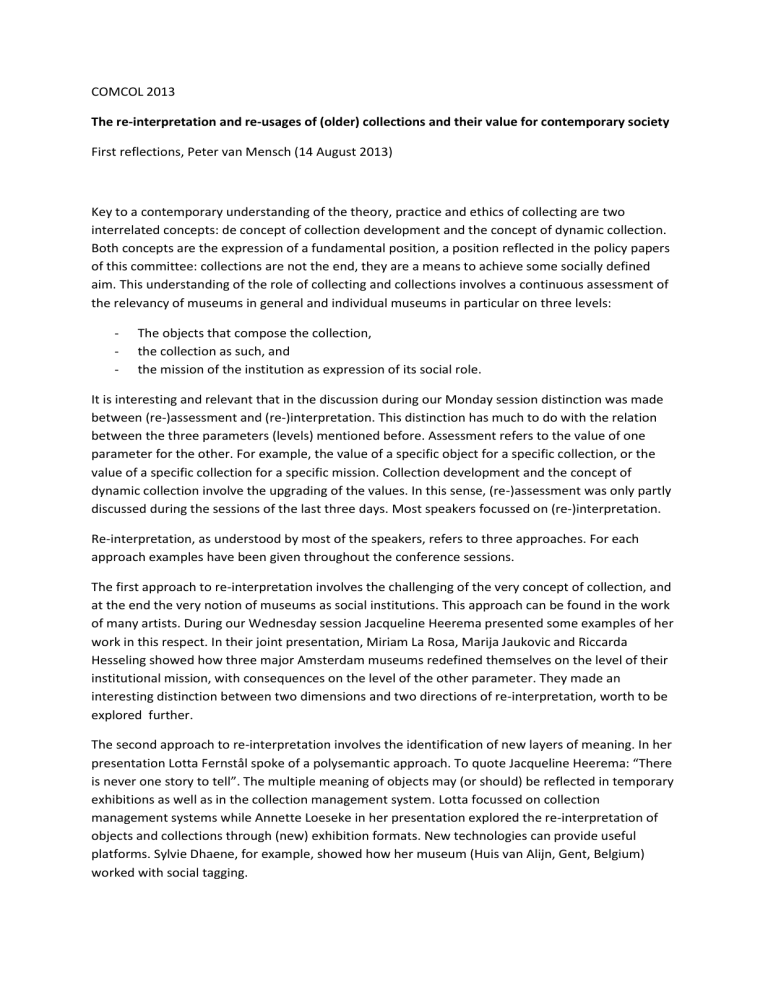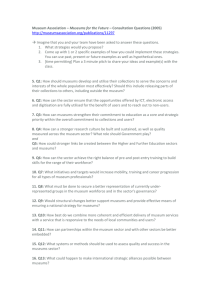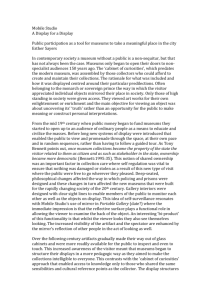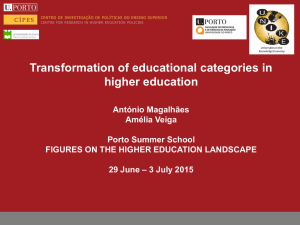First reflections by Peter van Mensch

COMCOL 2013
The re-interpretation and re-usages of (older) collections and their value for contemporary society
First reflections, Peter van Mensch (14 August 2013)
Key to a contemporary understanding of the theory, practice and ethics of collecting are two interrelated concepts: de concept of collection development and the concept of dynamic collection.
Both concepts are the expression of a fundamental position, a position reflected in the policy papers of this committee: collections are not the end, they are a means to achieve some socially defined aim. This understanding of the role of collecting and collections involves a continuous assessment of the relevancy of museums in general and individual museums in particular on three levels:
The objects that compose the collection,
the collection as such, and
the mission of the institution as expression of its social role.
It is interesting and relevant that in the discussion during our Monday session distinction was made between (re-)assessment and (re-)interpretation. This distinction has much to do with the relation between the three parameters (levels) mentioned before. Assessment refers to the value of one parameter for the other. For example, the value of a specific object for a specific collection, or the value of a specific collection for a specific mission. Collection development and the concept of dynamic collection involve the upgrading of the values. In this sense, (re-)assessment was only partly discussed during the sessions of the last three days. Most speakers focussed on (re-)interpretation.
Re-interpretation, as understood by most of the speakers, refers to three approaches. For each approach examples have been given throughout the conference sessions.
The first approach to re-interpretation involves the challenging of the very concept of collection, and at the end the very notion of museums as social institutions. This approach can be found in the work of many artists. During our Wednesday session Jacqueline Heerema presented some examples of her work in this respect. In their joint presentation, Miriam La Rosa, Marija Jaukovic and Riccarda
Hesseling showed how three major Amsterdam museums redefined themselves on the level of their institutional mission, with consequences on the level of the other parameter. They made an interesting distinction between two dimensions and two directions of re-interpretation, worth to be explored further.
The second approach to re-interpretation involves the identification of new layers of meaning. In her presentation Lotta Fernstål spoke of a polysemantic approach. To quote Jacqueline Heerema: “There is never one story to tell”. The multiple meaning of objects may (or should) be reflected in temporary exhibitions as well as in the collection management system. Lotta focussed on collection management systems while Annette Loeseke in her presentation explored the re-interpretation of objects and collections through (new) exhibition formats. New technologies can provide useful platforms. Sylvie Dhaene, for example, showed how her museum (Huis van Alijn, Gent, Belgium) worked with social tagging.
Polysemantic approaches towards heritage challenges the disciplinary approaches to classification.
During the Monday afternoon session this was briefly touched upon in the discussion. Significance is a social construct. An object in an art museum is framed as art, but the same object may be framed as historical document in a history museum. An object in a natural history museum may be framed by taxonomy as academic discipline, but may at the same time be historical evidence documenting the history of exploration, and so on. In this context it is relevant to refer to the concept of integrated museum as introduced at the 1972 conference at Santiago de Chile. It is wonderful that a reprint of the proceedings of this important conference is presented today. To link up with a contemporary professional discourse, one might say that re-interpretation involves liberating museum objects (or heritage in general) from the Authorative Heritage Discourse.
The third approach to re-interpretation involves the search for new relevancy; to connect old collections with contemporary social issues. An excellent example was provided yesterday in the joint session by Victoria Phiri (Moto Moto Museum, Zambia). The collection of Mbusa emblems was rediscovered as relevant teaching material to address contemporary health problems, such as
HIV/AIDS. To some extend Gudrun Fritsch’ paper followed a similar line of thought by exploring the contemporary relevancy of the work of the German artist Käthe Kollwitz.
Miriam La Rosa, Marija Jaukovic and Riccarda Hesseling reflected upon the possible cause of the
“sudden” interest in re-interpretation. Their hypothesis was that the participation paradigm was to blame. True or not, in any case, re-interpretation is a necessary policy for museums. However, as
Annette Loeseke showed us, in this process we should not forget our audiences The aim of reinterpretation should be making new connections, connections that are sustainable.






